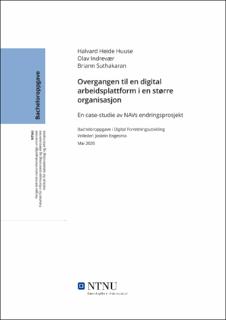| dc.contributor.advisor | Engesmo, Jostein | |
| dc.contributor.author | Huuse, Halvard Heide | |
| dc.contributor.author | Indrevær, Olav | |
| dc.contributor.author | Suthakaran, Briann | |
| dc.date.accessioned | 2020-08-16T16:01:43Z | |
| dc.date.available | 2020-08-16T16:01:43Z | |
| dc.date.issued | 2020 | |
| dc.identifier.uri | https://hdl.handle.net/11250/2672150 | |
| dc.description.abstract | Digitalisering og endringsledelse har den siste tiden spilt en stor rolle for mange organisasjoner, spesielt nå som arbeidshverdagen støttes av digitale arbeidsplattformer. Organisasjoner har brukt store summer for å forbedre de ansattes arbeidsmiljø, som innebærer omfattende endringer i organisasjonens praksis og de ansattes arbeidsvaner. Slike løsninger er nytt for mange og brukerne må tilvenne seg arbeidsmåten fortløpende. I den forbindelse oppstår det flere problemer underveis i endringsprosessen. Organisasjoner opplever for eksempel mangel på IT-kompetanse og gode rutiner som årsaker til at systemene ikke blir brukt optimalt. Om ikke løsninger blir brukt slik de er planlagt, vil ikke organisasjonen kunne oppleve alle fordelene den kan gi.
Formålet med oppgaven er å undersøke hvilke faktorer som påvirker de ansattes atferd og deres behov når et nytt IT-system skal innføres. I tillegg vil studien ta for seg, ved hjelp av både kvantitative og kvalitative forskningsmetoder, følgende problemstilling, som vil bli besvart i oppgaven: «Hvordan skal ledelsen legge til rette for brukeradopsjon av en digital arbeidsplattform gjennom en større heterogen og geografisk distribuert organisasjon?». For å diskutere problemstillingen vil den bli delt opp i to forskningsspørsmål, som også vil danne grunnlaget for anbefalinger til NAV: «Hvilke faktorer påvirker brukeradopsjonen av en digital arbeidsplattform?» og «Hvordan kan endringsledelse påvirke disse faktorene?».
Gjennom datainnsamling kom vi frem til tre problemområder rundt brukeradopsjon og brukeratferd for NAV. For å bedre dagens situasjon hos organisasjonen har vi etablert tre praktiske implikasjoner som søker å løse hovedproblemene, og dermed bedre brukeradopsjonen og brukeratferden hos de ansatte rundt endringen i organisasjonen. Implikasjonene bygger på påvirkningsfaktorer for brukeradopsjon og benytter seg av endringsledelses tiltak for å øke ansattes bruk av den digitale arbeidsplassen.
Denne studien kan bidra til å bedre adopsjon og de ansattes brukeratferd rundt en digital endring i større organisasjoner etter den er innført, så vel som å hjelpe en organisasjon i nye digitale endringsprosjekter. Den viser at brukeradopsjon av en digital endring er en langvarig prosess som påvirkes av flere faktorer i samspill med hverandre. Individets intensjoner om å bruke et system og deres holdninger til det er avgjørende, men disse faktorene påvirkes av fasiliterende betingelser som individet ikke har kontroll over selv. Disse betingelsene er tiltak som opplæring og at ledelsen går frem som gode eksempler av brukeratferd, noe som er klare praksiser fra endringsledelse. Forskningen viser da at endringsledelse har betydelig påvirkningskraft på brukeradopsjon, både før, under, og etter implementeringen av en digital endring. | |
| dc.description.abstract | In recent years, digitalization and change management have played a large role in many organizations, especially in these times where day-to-day work is supported by digital workspaces. Organizations have spent vast amounts of money improving the employees work environment, which involves extensive changes to the organizations practice and the work habits of the employees. Solutions like these are brand new for many users, and they will have to learn as they go. Because of this a multitude of problems can arise during the change process. For instance, many organizations experience a lack of IT-knowledge and proper routines are the cause of many of their woes and lead to suboptimal use of the system. If these systems are not used in their intended way, they will not yield the benefits they are supposed to.
This thesis seeks to uncover the most decisive factors in changing employee behaviour and what their needs are when a new IT-system is introduced. Additionally, the study will look at, through both qualitative and quantitative methods of research, the issue of: “How can the management facilitate user adoption of a digital workspace within a larger heterogenous and geographically distributed organization?”. To discuss this issue, it will be divided into two research questions, which in turn will make up the foundation for recommendations to NAV: “Which factors affect user adoption of a digital workspace?” and “How can change management can affect those factors?”.
Through collection of data, we arrived at three main problem areas pertaining to user adoption for NAV. To improve their current situation vi established three practical implications which seek to solve these problems, and therefore improve user adoption and user behaviour in the organization. The implications build on factors impacting user adoption and utilize measures in change management to increase the use of the digital workspace.
This study can contribute to better user adoption and user behaviour in digital change in larger organizations both after a change is introduced, as well as helping in new digital change projects. It shows that user adoption of a digital change is a long process which is affected by multiple factors all in interplay with each other. The individual’s intentions of using a given system and their attitude is crucial, but these factors are affected by facilitating conditions of which the individual has no control. These conditions are measures such as training and management setting a good example for user behaviour, which are practices described in change management. Research shows that change management has a significant influence over user adoption, both before, during, and after the implementation of a digital change. | en |
| dc.publisher | NTNU | |
| dc.title | Overgangen til en digital arbeidsplattform i større organisasjon: En case-studie av NAVs endringsprosjekt | |
| dc.type | Bachelor thesis | |
